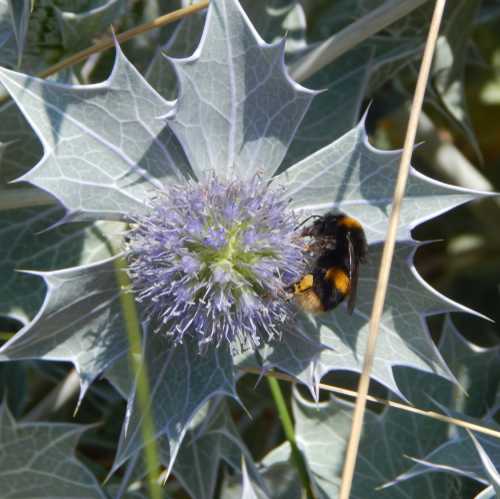Bee With A Broken Leg
Updated: 30th April 2021
Here is a query I have recently received:
"I have a bee with a broken leg. Can I nurse it back to health and will it survive?
I think it is a bumble bee. I have it in a box with some flowers and have offered some sugar water. Will it live and when will it be alright for me to set it free?"
- Katja
Since I occasionally receive queries about helping bees with injuries (although mostly about helping a bee with a damaged wing), I thought I would share my response.
Compassion for bees
Firstly, let me say, I am always touched and happy that so many people feel such compassion for bees that they would try to assist a bee with an injury.
However (and I state this with genuine kindness) there is usually nothing you can do. In such scenarios, it is always best to leave the bee alone and allow nature to take its course.
It may comfort you a little to know that most bees have short lives - just a few weeks. It is not uncommon - especially for older bees, to become more ragged looking and for such bees to be seen with damaged, ragged wings and so on, as they reach the end of their lives.
 Bombus terrestris - Buff tailed bumble bee on sea holly.
Bombus terrestris - Buff tailed bumble bee on sea holly.Is there anything you can do at all?
If the bee is not moving, you could drip a little sugar water close to the bee. If the bee wants to feed, it may do so. You never know, it may revive sufficiently to fly off. N.B. Update: Please ensure the bee does not get sugar water on its wings, and see this guide before attempting to feed sugar to bumble bees.
If not, you may have to accept the bee may never recover. Actually, there may even be something else wrong with the bee that has nothing to do with the injury - such as an internal parasite.
Anyway, it is best not to attempt to move a bee with an injury - this may only cause further damage.
Can an injured bee survive?
 Bombus pascuorum - common carder bumble bee on knapweed.
Bombus pascuorum - common carder bumble bee on knapweed.In actual fact, I know that bees can sometimes survive injury, although I am not sure how long for, and perhaps not long at all.
I believe the instinct of the bee to work and perform its function within a colony is so strong, they will always do their best to carry on if possible, despite being hampered. However, I'm sure this would depend on the degree of the injury.
Here is a personal experience:
One summer I was sitting on the beach. Behind me were sand dunes and wildflowers. Nevertheless, I was quite surprised when a common carder bumble bee (Bombus pascuorum) worker landed on my shorts.
I then noticed that it had one leg partly missing - the middle leg. I watched it and was careful not to disturb it.
After a short rest, the bumble bee took off again, flying up toward the flowers, despite the missing limb.
I suspect the bee may have had a shorter life than other members of its colony, but I cannot know whether this was definitely the case, and simply felt relief that the bumble bee was at least able to fly off.
Accidental injury
It's unfortunate, but injuries sometimes occur when people who mean well, try to 'help' bees, for example, by rescuing bees from spider webs.
On these occasions, it is tempting to try and pull at bits of spider web that remain attached to the bee, sometimes unfortunately catching or damaging a wing or limb in the process.
 This bee has already been parcelled up by the spider. It's too late to perform a rescue.
This bee has already been parcelled up by the spider. It's too late to perform a rescue.
In scenarios such as this, it is best to scoop the bee out of the web, but then leave the bee to disentangle itself from the web on its own.
The bee's body is covered in a fine coating of oil, thus enabling the bee to free itself usually within a few minutes.
Conclusion
Your kindness and efforts to help bees are always appreciated. Whilst you may not be able to help a bee with a broken leg or other injury, remember that by including plants in your garden for bees, you'll will be assisting bees and other pollinators a great deal.
Bless you!
More information
- Safe Bee Swarm Removal for Free – A great and simple guide
Bee Swarm Removal Advice. Swarming honey bees may move on of their own accord, otherwise it's possible to have bees removed humanely, sometimes free of charge. - Bee Nest Under The Garden Decking? What Should I Do? Free Advice
I sometimes get asked for advice about bee nests beneath garden decking - often it's bumble bees. If this is your concern, you may find the following useful. - Can I Remove A Bumble Bee Nest From A Compost Bin?
Can I Remove A Bumble Bee Nest From A Compost Bin? One common query concerns the desire to move a bumble bee nest out of a compost bin. Here's my advice. - Bee Nest By The Door - What Should I Do?
Bee Nest By The Door - What Should I Do? Advice here. - Disturbed A Bee Nest? What Should You Do?Disturbed A Bee Nest, or want to help a nest that has been damaged? How about a nest in an inconvenient place? Here is some advice about what to do.